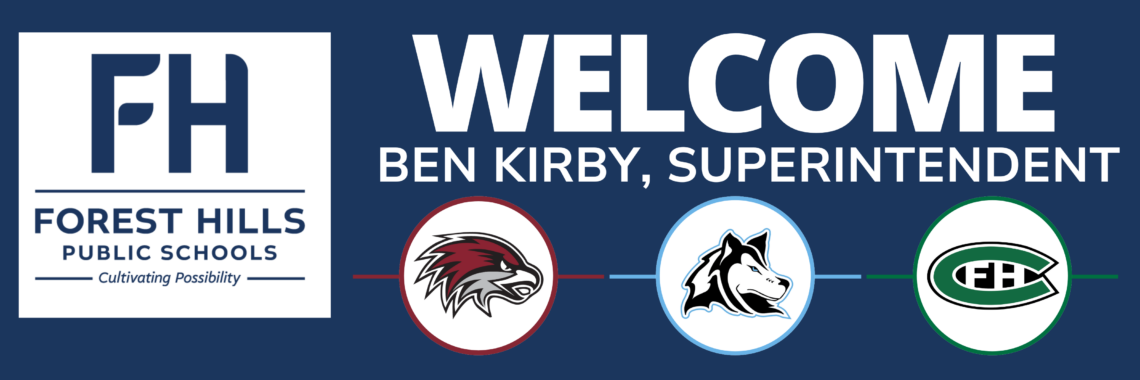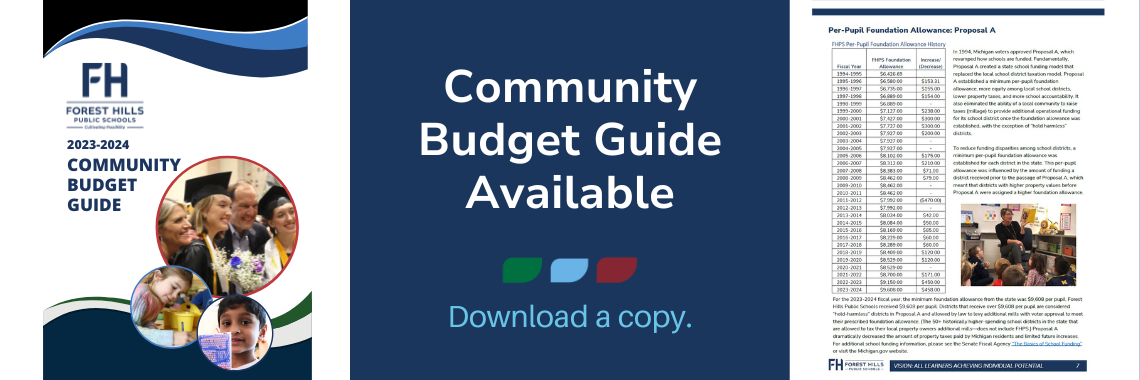Quick MAP Facts for FHPS
- Assesses mathematics and English language arts.
- Provides a consistent measure of academic growth within and across grade levels.
- Provides for a comparison of individual student academic performance to national normative data.
- Supports the partnership between a student, teacher, and family as the student works to achieve academic standards.
- Helps EACH learner grow and progress academically.
- Aligns with the District’s vision of all learners achieving individual potential.
How is MAP different than M-STEP, the Michigan Student Test of Educational Progress?
In Forest Hills we use the MAP as an internal, district provided, measure of growth and performance. MAP assessments are given two or three times a year for each student depending upon the school and/or grade level. On average, each subject area takes approximately 45 minutes to complete. M-STEP is a federally-mandated set of tests given to all Michigan public school children in grades 3-8 and 11. M-STEP is specifically designed to measure student academic performance in relation to Michigan Academic Standards in English language arts, mathematics, science, and social studies. The M-STEP is given once in the spring of each school year. M-STEP results are used to report both individual student performance to families and overall school performance to the public.
What if I have more questions about MAP tests?
Additionally, NWEA’s website, provides information on MAP assessments that families can use through its “Resources for Parents” web page. This page includes a short “Parent Toolkit” with tips on supporting your child’s development in reading and math.
Please continue to work in collaboration with your child’s teacher(s) to support his or her learning and interests at home. If you have further questions related to your child’s progress in school, please contact your school staff. FHPS is committed to partnering with you in the education of your child.
What are the MAP assessments®?
The Measures of Academic Progress (MAP) are a set of computer-based assessments in reading, language usage, and mathematics. MAP tests were designed by Northwest Evaluation Association (NWEA) whose mission is “partnering to help all kids learn®.” The tests are computer- adaptive, which means they adjust the difficulty of test questions for each student depending upon whether the previous question was answered correctly or incorrectly. In this way, MAP results provide insight into each student’s academic readiness and growth over time.
What is the purpose of MAP testing?
Each MAP test provides a single “snapshot” of students’ foundational skills and knowledge as they progress through grade levels. Although the tests themselves are built around a progression of skills and knowledge that are independent of grade level, MAP results provide teachers with information useful for supporting and monitoring students as they work toward the end-of-year grade level curriculum standards. When used in combination with other academic measures in the classroom, MAP is an effective tool for supporting every student’s academic growth within and across grade levels.
How do I know how my child did on the MAP assessments?
Individual student MAP results are reported in RIT scores (short for Rasch Unit). A RIT score is an estimation of a student’s instructional level. We often refer to RIT as “ready for instruction today” because it helps us determine where to go next with each child.
MAP assessments also provide percentile performance indicators that are useful for comparing your child’s performance to a national sample of students in the same grade level taking the MAP test at approximately the same time of year. The current “2015 Norms” were calibrated by NWEA using several years of national data.
Percentiles are used to describe your child’s performance in comparison to students with lower test scores. For example, a student whose RIT places him in the 50th percentile had a higher score than 50% of the students in the national comparison group for that grade level. Percentiles are not the same thing as percentage correct; the 50th percentile represents the mean or average score for a comparison group.
RIT and percentiles are not an indication of Michigan grade level performance. Only tests that specifically measure performance against grade level standards can tell whether your child is performing at, above, or below grade level expectations. MAP results are not used for the purpose of providing grades for students in FHPS.
It is important to understand that each MAP is a single test at one point in time. MAP tests do not measure intelligence or a student’s capacity for learning. Many factors can influence a student’s performance on a computer-based assessment (positively or negatively). Therefore, our teachers use MAP results along with many other measures of student learning, including classroom performance data, to ensure your child’s academic growth and development.
How can I use the Lexile® Range on my child’s MAP reading tests to help my child grow as a reader?
The MAP reading test includes a 150 point Lexile® Range in addition to the RIT score for reading. The Lexile® framework was developed by MetaMetrics to help match readers to texts. NWEA has correlated each reading RIT score to a corresponding Lexile® measure1. Since Lexile® is a popular scale for communicating the difficulty level of books or other types of texts, knowing your child’s Lexile® Range can be helpful when picking out things for him/her to read. Books with Lexile® ratings that fall within the first 100 points of your child’s Lexile® Range should represent texts that he/she can read on his/her own with a high level of engagement and appropriate level of challenge to grow as a reader.
When reading books that fall in the top 50 points of his/her range, your child may require a little more support from you. Texts that fall below your child’s Lexile® Range, may be appropriate for introducing entirely new subjects when more difficult vocabulary and syntax might distract from the content.
Finally, your child might find books above his/her Lexile® Range more enjoyable when he/she has prior knowledge of the subject matter. Visit www.lexile.com to search from among thousands of book titles to find texts for your growing reader. Please be aware that the Lexile® scale is not an indication of the age-appropriateness of any text it is used to measure.
1For emerging readers, a “BR” may be displayed if the correlated RIT score does not yet fall within the Lexile® scale bands.








